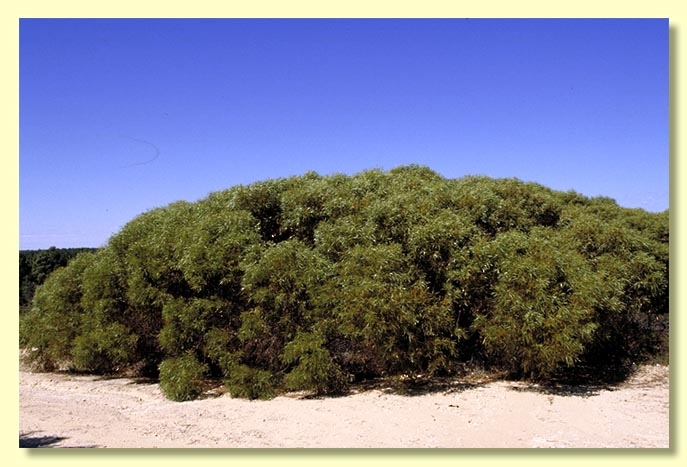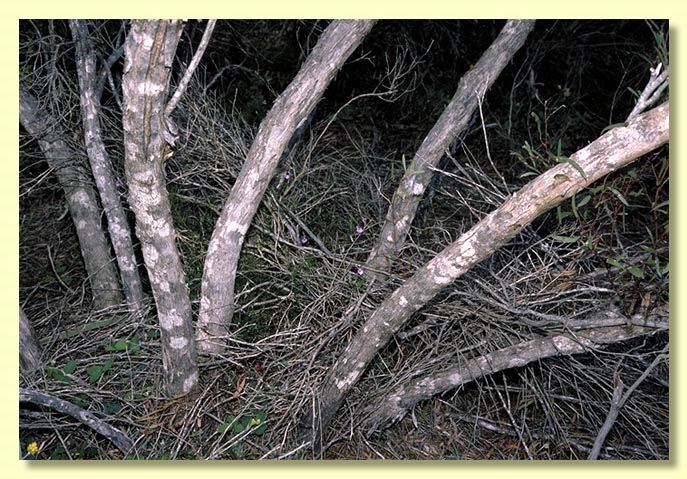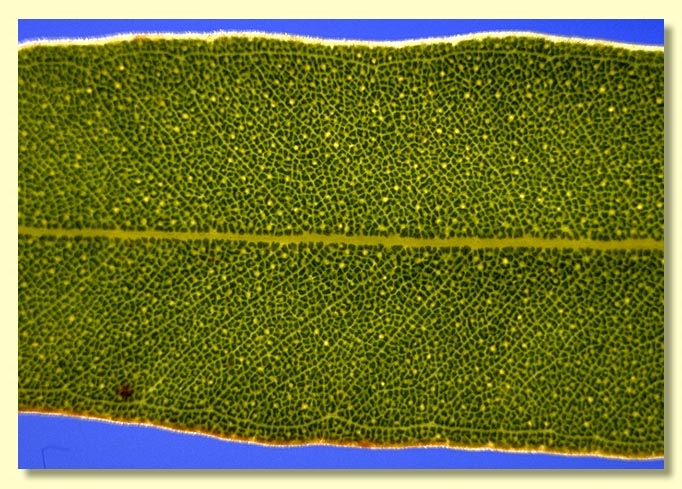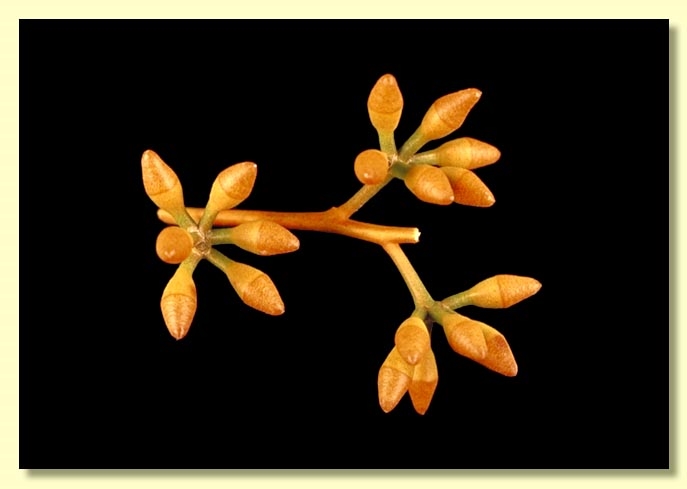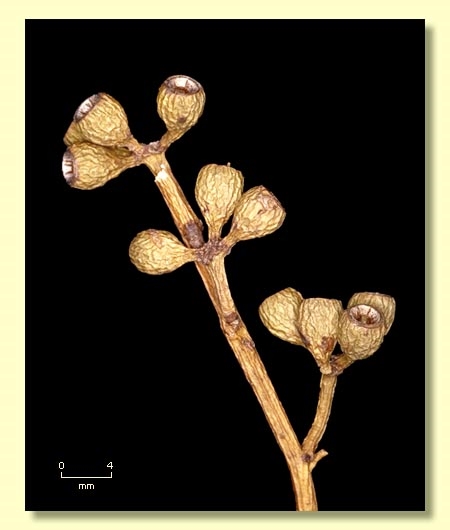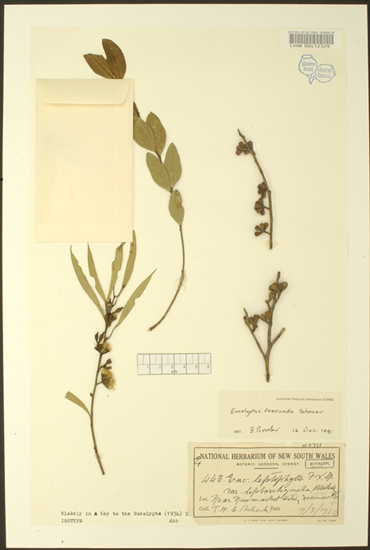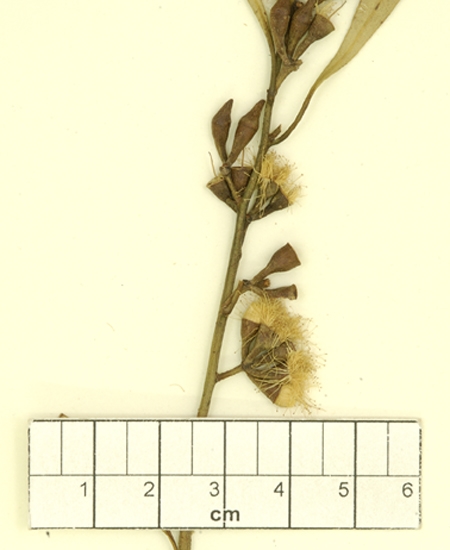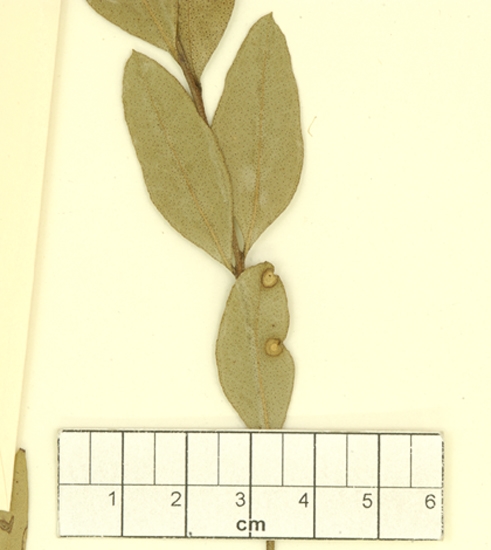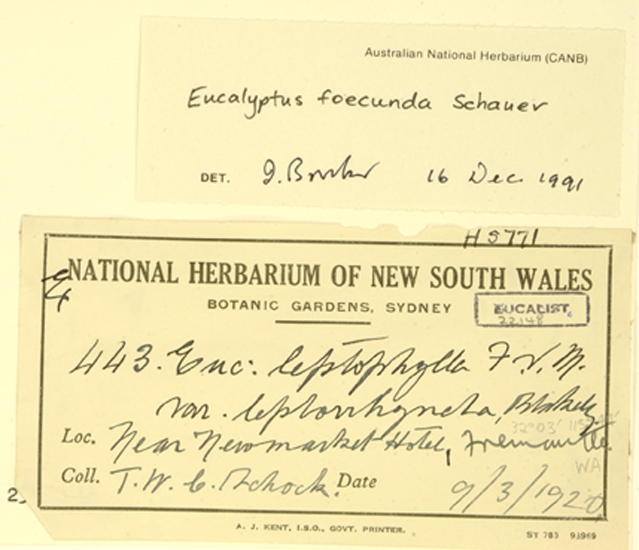Euclid - Online edition
Eucalyptus foecunda
Eucalyptus | Symphyomyrtus | Bisectae | Destitutae | Porantherae | Longiores
Bark rough over part or all of trunks, firmly held, thin and fibrous to loose and flaky, grey to blackish, smooth above pale grey and pale brown.
Branchlets lacking oil glands in the pith.
Juvenile growth (coppice or field seedlings to 50 cm): stems rounded in cross-section, usually not glaucous; juvenile leaves shortly petiolate, alternate, elliptic to lanceolate or linear, 4–8 cm long, 0.5–2 cm wide, base tapering, margin entire, apex pointed, dull, usually green.
Adult leaves alternate, petioles 0.5–1.7 cm long; blade narrowly lanceolate to narrowly elliptic-oblong, 5–9.5 cm long, 0.5–1.3 cm wide, base tapering to petiole, margin entire, apex pointed, concolorous, glossy, green, side-veins greater than 45° to midrib or obscure, reticulation dense or obscure, intramarginal vein present, oil glands intersectional or obscure.
Inflorescence axillary unbranched, peduncles 0.5–1.3 cm long, buds 9 or 11 per umbel. Mature buds pedicellate, pedicels 0.2–0.5 cm long, ovoid to fusiform (0.6–1 cm long, 0.3–0.4 cm wide), scar present, operculum conical to beaked (0.25–0.6 cm long), stamens inflexed, anthers cuneate-cuboid, adnate to filament apex (rigidly basifixed), dehiscing by sub-terminal pores, a few of the innermost stamens imperfectly formed, style long and straight, stigma tapered, locules 3, the placentae each with 4 vertical rows of ovules. Flowers creamy white.
Fruit pedicellate (pedicels 0.2–0.4 cm long), cupular to slightly urceolate, 0.4–0.6 cm long, 0.4–0.6 cm wide, disc usually descending, valves 3, more or less enclosed.
Seeds brown-grey, 1–1.5 mm long, flattened-ovoid, dorsal surface sometimes furrowed longitudinally, the surface smooth, hilum ventral.
Cultivated seedling (interpreted from the literature): cotyledons Y-shaped (bisected); leaves opposite for at least 10 nodes, sessile to shortly petiolate, narrowly elliptical becoming narrowly lanceolate, 4–6 cm long, 0.7–1 cm wide, green.
Flowering time unknown.
A mallee endemic to Western Australia found only in coastal areas near Perth, from south of Mandurah to north of Lancelin, always on limy sands. The bark is rough over most of the trunks and the adult leaves glossy green.
Eucalyptus foecunda belongs in Eucalyptus subgenus Symphyomyrtus section Bisectae subsection Destitutae because the buds have two opercula, cotyledons are Y-shaped and branchlets lack oil glands in the pith. Within this subsection E. foecunda is one of a group of about 16 species, series Porantherae, that are further characterised by having anthers completely adnate to the staminal filaments, strongly inflexed stamens, densely reticulate leaves with intersectional oil glands and by the fruit with a distinct thick rim that includes a whitish descending disc. The small, glossy leaves of species in series Porantherae may result in confusion with species in series Heterostemones; however, the fruit alone usually distinguish the series. The fruit of series Heterostemones are thin-rimmed.
E. foecunda was once confused with E. leptophylla, which is predominantly an eastern Australian species with smooth bark, broad grey or glaucous elliptical juvenile leaves and blunt opercula. E. foecunda has lanceolate, green juvenile leaves and very acute opercula. Two other species of series Porantherae have a strictly west coastal distribution and therefore are likely to be confused: E. fruticosa, which occurs on red sands north from Kalbarri and has glaucous juveniles and a crown of mixed adult and juvenile leaves; and E. sp. Kalbarri, which has larger, more barrel-shaped fruit than either E. foecunda or E. fruticosa and more ovate green juvenile leaves. To the east of the distribution of E. foecunda in the start of the wheatbelt there are three species that should not be confused: E. albida, a smooth-barked mallee with white-glaucous orbicular sessile juveniles; E. horistes, a partly rough or smooth-barked mallee with slightly warty glaucous orbicular juveniles; and E. rigidula, a smooth-barked mallee with green linear to lanceolate juveniles.
In the area immediately north of Coolimba (south of Dongara on the west coast) plants with prominently beaked opercula and thin, ribbony rough bark to more or less smooth bark occur on white limy sands. These plants have been referred to as E. foecunda "Cliff Head form" or by the unpublished name E. aeolica. Further study is required to determine their status.

